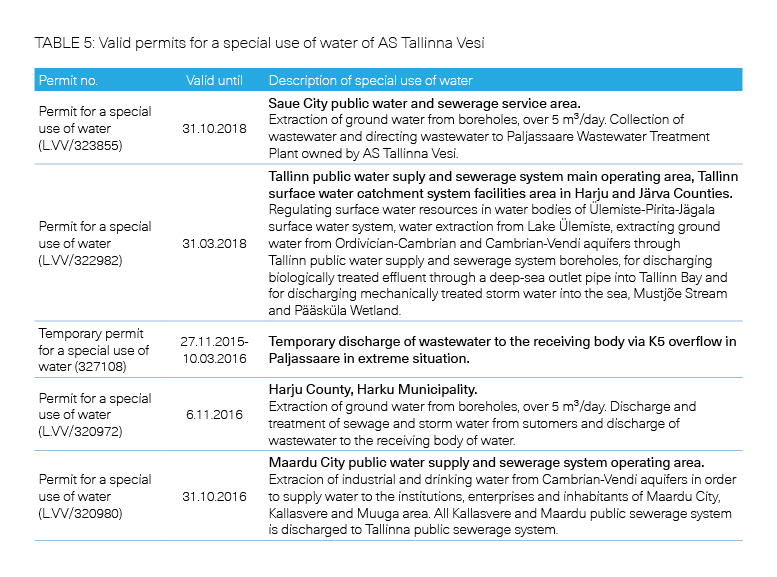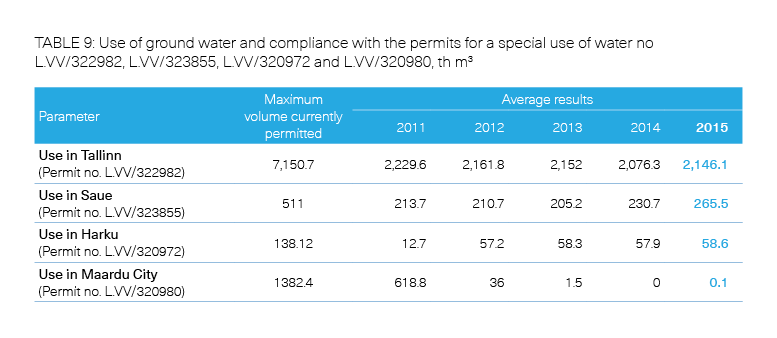Quality and Use of Water Resource
Permits for special use of water
Our activities in using water resources are regulated by the Water Act and its implementing provisions. As a water company we must hold a valid permit for a special use of water for a specific term and pay a fee for the water resource we have used. The permit for a special use of water involves certain obligations and restrictions (e.g. the permit sets out the allowed water extraction volume (m3)), keeping the account of water, metering ground water level, requirements for sampling, monitoring and analyses, as well as the allowed limit values for pollutants in effluent, requirements for monitoring the pollutants and the measures to reduce the impact of a special use of water).
All requirements established in the permits for a special use of water were met in 2015. Fee for a special use of water is paid for the amount of water taken into Ülemiste Water Treatment Plant and for the ground water pumped from the aquifers. In 2015, the fee for a special use of water amounted to 4.6% of the costs of the sold products/services.
Water catchment
Nearly 90% of our consumers in Tallinn and Maardu get their drinking water from the surface water resources. Even though Lake Ülemiste is the main drinking water source for Tallinn, the natural catchment of the lake itself is small. To increase the water volume and ensure that the needs of the City of Tallinn are met, we have built a water catchment system, which consists of hydropoints constructed on rivers, as well as water reservoirs and channels connecting those. Our water catchment system mainly comprises Harju sub-basin and the river basins of Soodla, Jägala and Pirita Rivers with the total area of ca 1,800 km2. The most important water reservoir is Lake Ülemiste with a net volume of 15.8 million m3. Additional water reserves for dry periods have been accumulated to Paunküla water reservoir on the headwaters of the Pirita River (9.9 million m3) and to Soodla water reservoir on the Soodla River (7.4 million m3).
The volume of water resources in Tallinn surface water catchment system primarily depends on the annual amount of precipitation. Constant information on the flows allows us to use the water resource in the most efficient manner. To regulate the water resources in an optimum and accurate manner we have established water metering points at all hydropoints, which enable us to meter the flows conducted to the channels and the sanitary flows in the rivers. We perform metering regularly, as per the requirements of the permit for a special use of water.
2015 was a dry year and thus additional water was taken to Lake Ülemiste throughout the entire year. More than half of the water need was covered by water from Pirita-Ülemiste channel (15 million m3). Due to the low precipitation considerably smaller amount of nutrients were washed from soil into water bodies and this significantly improved the water quality in all water bodies. Single deviations clearly indicate the impact of human activity.
In order to protect the water resources and the water body used for the drinking water extraction, a sanitary protection zone around Lake Ülemiste has been formed. The sanitary protection zone comprises Lake Ülemiste, water catchment facilities, bank reinforcements and the land in the immediate vicinity of the lake, which needs to be kept in its natural condition. In addition, sanitary protection zones are formed in the catchment areas to protect the facilities of Soodla, Kaunissaare, Paunküla and Aavoja water reservoirs.
Use and quality of surface water
Pursuant to the permit for a special use of water no L.VV/322982, the Company is allowed to extract 47.60 million m3 of surface water per year from Lake Ülemiste. The actual surface water use in 2015 was 22.76 million m3.
The water quality in surface water sources is monitored in line with the programme established based on the conditions of the permit for a special use of water. In 2015, the quality of raw water in the treatment system complied with the class A2 requirements of the European Council Directive 75/440/EC. To ensure compliance, the raw water quality indicators are analysed once a day at the intake to the treatment system. The raw water pollution indicators, such as total phosphorus and total nitrogen, are analysed once a week. Furthermore, an in-depth analysis of raw water is carried out once a month in accordance with the drinking water quality monitoring programme. Based on the outcome from these results, we make an assessment of the changes and processes in the catchment area and make decisions regarding additional intake to supplement the water resources in the lake.
In 2015, raw water was of an average quality. In 2015, the permanganate oxygen demand was slightly higher than in previous year. Also the water colour parameters in raw water were higher.
Use and quality of ground water
Approximately 10% of consumers in Tallinn are supplied with water extracted from the Cambrian-Vendian and Cambrian-Ordovician aquifers. Ground water is supplied in the districts of Nõmme, Laagri, Merivälja, Pirita and Tiskre in Tallinn, Tiskre village in Harku Rural Municipality and City of Saue. Total of 2,470,177 m3 of ground water was extracted in 2015.
According to the EU Water Framework Directive (2000/60/EC), the qualitative or chemical condition of ground water is regarded to be good if the concentration of pollutants does not indicate an inflow of salty water or other water, nor does it exceed the respective quality standards. In 2015, the quality of drinking water at the borehole pumping stations complied with the requirements of the Regulation No 82, issued by the Minister of Social Affairs. There were no ground water pollution incidents or potential pollution incidents demanding the notification of the City of Tallinn and the Health Board.
We monitor the ground water quality parameters in accordance with the permits for a special use of water and the drinking water source quality monitoring programme, and if necessary, the ground water will undergo a treatment process. We monitor the treated ground water quality (content of iron, manganese, and ammonium) at 20 ground water pumping stations on a monthly basis. All bore-wells of the Company currently in use are equipped with automatic hydrostatic pressure sensors, which enable to measure the static and dynamic level of ground water. The results of this measuring enables us to assess the recovery of ground water resources.
Ground water in Northern Estonia (Cambrian-Vendian aquifer) contains natural radionuclides. The natural radioactivity of Estonian ground water has been thoroughly studied by the Geological Survey of Estonia, as well as the Estonian Radiation Centre. To assess the health impacts of radioactivity, the Radiation Centre together with the Health Board carried out a health risk assessment in Tallinn ground water areas in 2010. Based on the results of this risk assessment, any random health damage resulting from the content of radionuclides in the water of Cambrian-Vendian bore-wells is unlikely. Repeated radiological analyses in all the bore-wells are carried out in every ten years, in accordance with the requirements.




